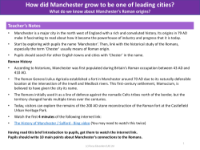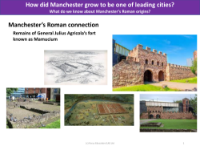What do we know about Manchester's Roman origins? - Presentation

History Resource Description
Manchester's origins can be traced back to Roman Britain, where it was known as Mamucium. Established around 79 AD, the city's name is believed to have been derived from this early Roman settlement. The location was strategically chosen by the Roman General Julius Agricola due to its defensible position at the confluence of the rivers Irwell and Medlock. Initially serving as a fortification against the Celtic tribes to the north, Mamucium was part of a wider network of Roman defences. Over the centuries, the fort saw multiple reconstructions, including a significant stone fort built in 200 AD. Today, the remnants of Manchester's Roman past can be explored at the Castlefield Urban Heritage Park, where the reconstructed parts of the fort stand as a testament to the city's ancient history.
The term 'Chester' in a place name often indicates Roman origins, and Manchester is no exception. Students learning about Manchester's history are encouraged to investigate other British towns and cities with 'Chester' in their names to discover their Roman connections. By examining the remains of the fort known as Mamucium and researching the city's Roman past, pupils can gain insights into how Manchester evolved from a Roman outpost to one of the leading cities in England. The study of Manchester's Roman origins is a key aspect of understanding the city's historical development and forms a foundational part of the local history unit in the National Curriculum for Key Stage 2.




